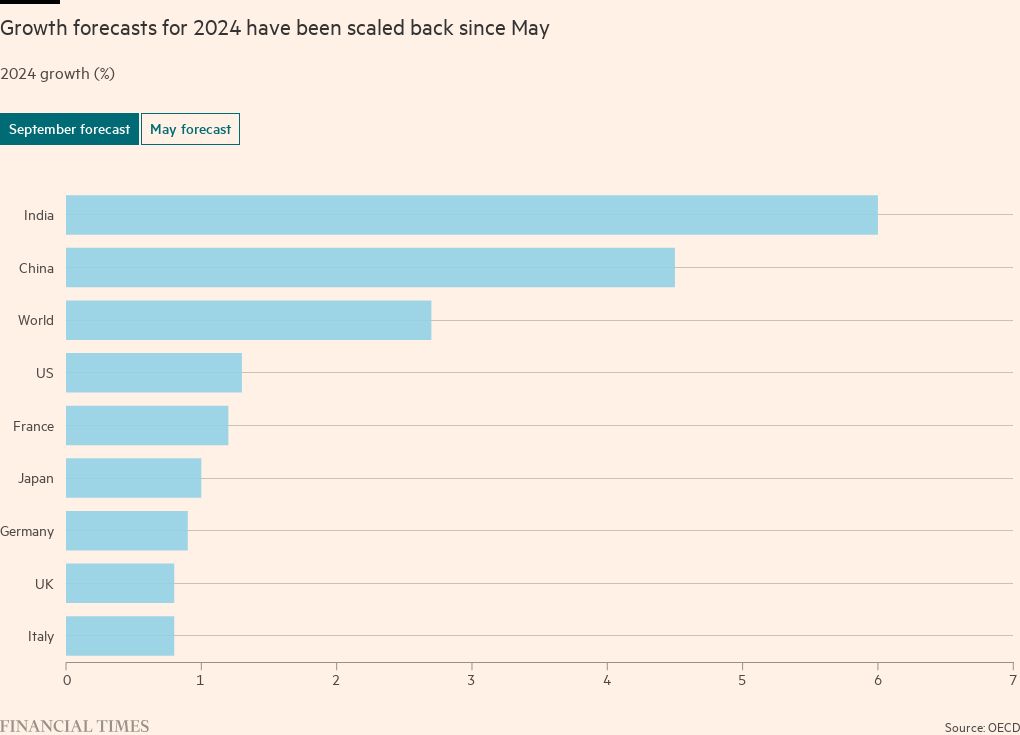
Receive free updates on global economic growth
we will send you myFT Daily Digest Email summary of latest information global economic growth There is news every morning.
The OECD said central banks should keep interest rates at current high levels or raise them further to curb inflation despite “increasingly clear” signs of global economic stress and protectionism.
The Paris-based group representing rich countries said on Tuesday that lasting progress in defeating inflation was needed before easing monetary policy could be considered.
The advice comes ahead of key decisions by the Federal Reserve this week, with economists expecting the Fed to pause rate hikes for a second time on Wednesday and the Bank of England expected to raise interest rates for a 15th consecutive time. .
In its medium-term economic outlook The OECD lowered its forecast for 2024 and said “the impact of tighter monetary policy is increasingly evident – business and consumer confidence has declined and the rebound in China has faded”. It also warned that a wave of protectionist measures was harming global trade.
But its chief economist Clare Lombardelli said that even in the United States, where evidence of inflation “looks more positive”, it was “too early to declare victory” in the fight to contain price pressures and cut interest rates. “.
The OECD recommends that the Federal Reserve keep interest rates at the current range of 5.25% to 5.5% until the second half of 2024, while the European Central Bank and the Bank of England further tighten policies.
Lombardelli told the Financial Times that the central bank should wait until many indicators – including headline inflation, core inflation, wage pressures and corporate pricing behavior – cool down before loosening the brakes on the economy.
But signs are growing that high interest rates are limiting economic activity, the OECD said. With the exception of Japan, forward-looking interest rates, which adjust for expected inflation, are now positive in most countries, business surveys are trending downward and financial conditions are tightening.
With European bank lending slowing sharply, “even if policy rates are not raised further, the impact of past rate hikes will continue to affect economies,” the report said.
But there are signs that not all inflationary pressures are easing, such as a 25% rise in oil prices since May, with benchmark Brent crude nearing $95 a barrel.
The OECD predicts that China’s economic growth will slow down, and that growth will fall further below the Chinese government’s official target of “about 5%” in 2024. The group warned that a faster slowdown in China’s economic growth would have significant spillover effects in the rest of the world.
A 3% drop in China’s domestic spending will be directly transmitted to Asian economies and commodity exporters through trade, while the United States and Europe will only be severely hit if global stock markets fall sharply and investors demand higher lending rates.
The OECD estimates that if China’s economic and broader financial shocks occur at the same time, global economic growth will be reduced by more than a third.
The most effective action economic policymakers can take to boost short-term growth is to remove some of the recently erected trade barriers, the group said.
The slow recovery in global goods trade in the post-Covid-19 period is holding back growth in productivity and prosperity levels, the report said.
“People are right to worry about security, but you don’t need to reduce trade to build resilience,” Lombardelli said.
Svlook










